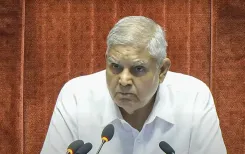How Did Unemployment Drop from 6% to 3.2% in Just 6 Years and Inflation Reach Record Lows?

Synopsis
Key Takeaways
- Unemployment reduced from 6% to 3.2% in six years.
- Inflation reached a six-year low.
- Support for 81 crore beneficiaries through food security programs.
- Multiple employment generation and skill development initiatives launched.
- Strategic measures to control inflation and enhance household income.
New Delhi, July 21 (NationPress) In a recent address to Parliament, Finance Minister Nirmala Sitharaman revealed that the government has implemented a variety of strategies that successfully decreased the unemployment rate in the nation from 6 percent to 3.2 percent over the past six years, while also lowering inflation to a historic low.
In her written response to questions in the Lok Sabha, the minister highlighted that multiple initiatives were launched to manage inflation, alongside enhancing sustainable employment opportunities and boosting household incomes, especially for the poor and younger demographics.
These initiatives encompass, among others, the enhancement of buffer stocks for essential food items, strategic sales of procured grains in the open market, facilitating imports, and imposing export restrictions during times of scarcity. Additionally, implementing stock limits to increase the supply of specific commodities in the market, retail sales of selected food items at subsidized prices under the Bharat brand, and the distribution of food grains free of cost to approximately 81 crore beneficiaries under the National Food Security Act were key measures.
The government also raised individuals' disposable income by exempting annual incomes up to Rs 12 lakh (and Rs 12.75 lakh for salaried individuals after standard deductions) from income tax, the minister noted.
She elaborated that due to these various measures, the average retail inflation rate (year-on-year) as measured by the Consumer Price Index (CPI) fell from 5.4 percent in 2023-24 to 4.6 percent in 2024-25, marking the lowest level in the last six years.
Additionally, CPI averaged 2.7 percent in the first quarter of 2025-26, concluding the quarter at 2.1 percent in June 2025. Food inflation also saw a decline, hitting negative territory with a rate of (-) 1.06 percent in June 2025, the lowest since January 2019, she added.
FM Sitharaman also emphasized that alongside inflation control initiatives, several steps were taken to broaden job opportunities through various employment generation and skill development programs, such as the Prime Minister’s Employment Generation Programme, Aatmanirbhar Bharat Rojgar Yojana, Employment-Linked Incentives for industries, National Urban/Rural Livelihoods Missions, Mahatma Gandhi National Rural Employment Guarantee Scheme, and Kaushal Vikas Yojanas.
Moreover, the ‘Rural Prosperity and Resilience’ program was introduced in the Union Budget 2025-26 to combat underemployment in agriculture through skill development, investment, and technology, particularly targeting women, youth, and marginal farmers.
As a result of these initiatives, the all-India annual unemployment rate for individuals aged 15 years and older (according to usual status) fell from 6 percent in 2017-18 to 3.2 percent in 2023-24, the Finance Minister concluded.





